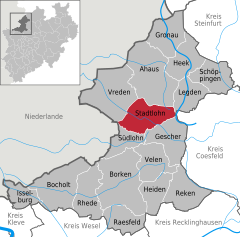Stadtlohn
| Stadtlohn | |||
|---|---|---|---|
 |
|||
|
|||
| Coordinates: 51°59′33″N 06°54′54″E / 51.99250°N 6.91500°ECoordinates: 51°59′33″N 06°54′54″E / 51.99250°N 6.91500°E | |||
| Country | Germany | ||
| State | North Rhine-Westphalia | ||
| District | Borken | ||
| Government | |||
| • Mayor | Helmut Könning (CDU) | ||
| Area | |||
| • Total | 79.06 km2 (30.53 sq mi) | ||
| Population (2015-12-31) | |||
| • Total | 20,411 | ||
| • Density | 260/km2 (670/sq mi) | ||
| Time zone | CET/CEST (UTC+1/+2) | ||
| Postal codes | 48703 | ||
| Dialling codes | 0 25 63 | ||
| Vehicle registration | BOR | ||
| Website | www.stadtlohn.de | ||
Stadtlohn is a town in the north-west of North Rhine-Westphalia, Germany, part of the district Borken. The Berkel river flows through it on its way to the Netherlands.
Stadtlohn consists of 9 districts:
The town was founded as Lohn by Liudger, the first Bishop of Münster about the year 800. About 985 Gescher was split form Lohn, which in turn (1231) split into Südlohn (literally "South-Lohn") and Nordlohn (literally "North-Lohn"). The name Stadtlohn (literally "Town-Lohn") is first mentioned in 1389 after the small town Nordlohn was secured by a moat, a defensive wall and gates and gained the town rights. About 1406 Stadtlohn was burned down by Count Heinrich I of Solms-Ottenstein because he feuded with the bishop of Münster. Bishop Heinrich III of Münster verified its town rights in 1491.
In 1584 Stadtlohn was pillaged by the troops of Duke Ernest of Bavaria and again in 1588 by Dutch soldiers. In 1591 Spanish soldiers attacked the town. For a few months of 1598 Spanish troops were stationed in the town during the Eighty Years' War. In 1611 a serious fire destroyed 225 of 235 houses.
On August 6, 1623 during the Thirty Years' War the Battle of Stadtlohn (German: Schlacht im Lohner Brook) saw Johan Tzerclaes, Count of Tilly's imperial troops victorious over Duke Christian of Brunswick's men. About 6.000 soldiers died that day. In 1742 regular pilgrimages started to a statue of Mary in a small chapel in Stadtlohn form various towns in the Münsterland. The adoration of the virgin Mary ended in 1886 when the statue was stolen from the Hilgenbergchapel.
...
Wikipedia





